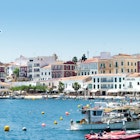Whether you are looking for a Mediterranean escape, a road trip through hilly wine regions, or an awe-inspiring art-fuelled tour through medieval cities, Italy will not disappoint.
But with a long list of attractions – whether they're culinary, scenic, architectural, historic or cultural – and many variables, planning a budget journey through Italy can be tricky. Prices often vary from season to season, but also from cities to countryside, and from north to south. There are regions that have a well-developed tourist infrastructure with an endless offering of ticketed things to do and a range of services that cater to every pocket, and there are other, less visited areas that are yet to be affected by tourism flows and provide many opportunities for low-cost discovery.
Here’s your insider guide to Italian money matters, with a top tips to help you save a few euros as you travel through the 20 regions that compose this diverse peninsula.

Fly into secondary airports or enter Italy overland
Most foreign visitors will take a flight to reach Italy from abroad. Landing in secondary airports served by low-cost airlines can reduce your travel costs by a lot. You could fly into Bergamo to visit Milan, or check flights to Pisa or Bologna to get to Florence, for instance. Ryanair, WizzAir, EasyJet and Vueling all fly into Italy.
But flying isn’t the only way of getting to Italy. In 2021, a new high-velocity rail line connecting Paris to Milan and Turin was opened. It is now possible to travel with a Trenitalia train from the French capital into Italy for €69 (when booked in advance).
Shoulder season is the best season
Traveling to Italy in May and June or in September and October offers the best balance between weather, costs, and things to do. The peak holiday season runs between July and August – this is when most Italians go on vacation, when prices skyrocket, when the heat is hard to bear, and when beaches are packed. Visiting the country before or after this period provides the best chances of having pleasant temperatures, finding deals, and avoiding crowds.

Ditch the car and move around with public transport
While it is true that a rental vehicle will allow you to visit rural and mountainous areas with ease, public transportation connects most cities and can get you around with a small budget. Not all public transit options are the same, however – high-speed trains are fast but can be costly if booked on the spot; regional trains are slower, but can cost less than half of their high-speed counterparts; buses are the cheapest option available, although not the most comfortable.
Let’s say you want to travel from Rome to Florence next week: a high-speed train will set you back approximately €45; doing so on a regional regional train will amount to €23; and traveling the same distance on a Flixbus coach can cost as little as €7.
Discounts are often available for train trips, if you know where to find them
Yes, high-speed rail travel is the most expensive form of public transport, but this is not always true. Booking your seat a few weeks in advance will get you reduced price tickets for both Italo and Trenitalia fast trains.
If you are planning to move around a lot by train it is worth considering purchasing a Trenitalia Pass, which will allow you to travel for multiple days everywhere in Italy starting from €129. Trenitalia also provides special offers for same day return tickets and weekend return tickets.
Look out for lunch deals in trattorias
Street food is a great way to cut food costs in Italy, but you don’t always need to give up on the pleasure of sitting down at a local restaurant table to save money. Many trattorias and osterias around Italy offer fixed-price lunch menus including a pasta dish, a second course, water, and wine for under €15. Look out for signs promoting a menù del giorno (menu of the day).

Stand up for your coffee
Italians stop at cafes multiple times a day to top up their caffeine levels. The espresso ritual doesn’t change throughout the country – a strong shot of coffee is typically had standing at the bar in a matter of minutes. Many cafes, especially in larger cities, will charge a service fee if you sit down for your coffee.
Avoid bottled water, especially in Rome
Tap water is drinkable in Italy – take a refillable bottle with you to save some cash and reduce your consumption of single-use plastics. This is especially easy in Rome – Italy’s capital has over 5000 drinking fountains known as nasoni (big noses) spread through the city. Check out fontanelle.org for a map of all the drinking fountains in Rome.
Plan a low season art tour
Italy’s endless art heritage attracts a constant flow of tourists year-round, but visiting during the winter will reduce your chances of finding yourself jostled in a crowd. Many art institutions also offer discounted tickets during the low season. For instance, an adult ticket for Florence’s Uffizi – one of Italy’s most visited museums – goes down from €25 to €12 between November 1 and February 28.
Go church hopping to admire the work of great artists
Museum tickets can quickly add up, but world-class art is not found in galleries alone. Italy has upwards of 100,000 churches on its territory and many of these religious structures contain exceptional icons of the country’s cultural heritage that can be admired free of charge. Caravaggio, Raffaello, Giotto, Lippi and Botticelli are just some of the names you can expect to encounter when entering churches in art cities like Rome and Florence.
Seek “free” beaches
Many public beaches in Italy are privately managed by businesses known as bagni that rent umbrellas and deckchairs to holidaymakers during the summer months. While this will guarantee a space on the sand for you to sunbathe in peace, it can set you back between €15 and €40 per day, depending on the location. To avoid paying for a spot on the beach, ask around for the nearest spiaggia libera (free beach), the coastal areas where access is free for all.
Walk a long-distance pilgrimage route
One of the most memorable experiences you can do in Italy is also one of the least expensive. Follow the footsteps of medieval pilgrims by hiking along one of the historic routes that are found throughout the country – the Via Francigena is the best known itinerary of this kind, running from Canterbury, England, all the way to Southern Italy, via Rome. Like on the Camino de Santiago, on the Via Francigena it is possible to sleep in monasteries and hostels that cater to modern-day pilgrims for a few euros per night. No time for hiking? A similar route can be done by bike.
A guide to daily costs
- Espresso coffee: €1.20
- Bed in a hostel dorm: €25 to €50 per night
- Double room in an agriturismo (farm stay): from €80 per night
- High-speed train ticket from Florence to Milan: €56
- Urban bus or tram ride: €1.50
- Glass of Chianti wine: €5 to €8
- Dinner for two: from €50
- Margherita pizza: €6 to €8
- Aperitivo cocktail: €5 to €10
- Sandwich: €5
- Car rental: from €50 per day
- One liter of petrol: €1.80
- Bicycle hire: €12 per day
- Museum tickets: €10 to €20
Your average daily spend for visiting Italy will vary depending on how often you choose to move and eat in restaurants, what distances you decide to cover, and whether you are traveling with someone else, but you should account for at least €130 per day if you plan to include major sights in your itinerary. Cutting down costs, however, is possible with the following tips.














